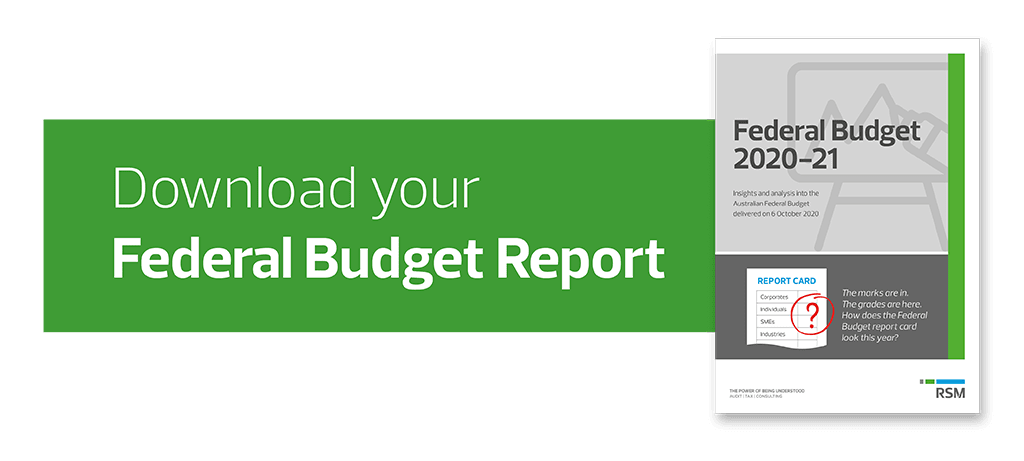What does the 2020-21 New South Wales state budget mean for you and your business?
The New South Wales (“NSW”) Government has taken on the challenge of making generational and big bang reform in the wake of COVID-19 in its 2020-21 Budget, delivered on 17 November 2020. While most other budgets in 2020-21, both state and federal, have tended to focus on infrastructure spending and have shied away from any major tax reform, the NSW Budget has shown it is possible to achieve both goals in the same budget cycle. 
The headline-grabbing reform is the proposed “tax mix switch” away from stamp duty towards a broader-based land tax. However, there are also significant payroll tax amendments announced as part of the Budget and specific incentives for small businesses whose turnover is too low to benefit from the payroll tax amendments. Outside of tax, there are significant, new infrastructure spending measures ranging from schools, hospitals and roads, and other public infrastructure.
In a story that has played out across Australia, the NSW Budget has been hit hard by falling GST receipts (estimated to be $8.7 bn less over four years) and a write-down in state revenues, particularly due to the depressed property and employment markets affecting stamp duty and payroll tax collections (estimated to be down by $2.3 bn and $6.8 bn respectively). As a result, the NSW Government is looking further at asset recycling, such as selling off its remaining 49% interest in the WestConnex Motorway and the potential sale of the state’s lotteries business.
The Government estimates that it has spent over $29 bn on COVID-19 pandemic related health and business measures and, at the same time, its forecasted revenues are down by $25 bn over the next five years. This has contributed to the budget deficit for the 2020-21 year being $16 bn. The Budgets over the forward estimates through to 2022-23 are expected to also remain in deficit, with 2024-25 being the anticipated return to surplus.
Early on in the pandemic, the NSW Government publicly stated that it would put businesses and the economy ahead of a budget surplus and this Budget delivers on that by being a “Recovery and Reform” Budget. It seeks to provide immediate and short-term relief to both households and businesses (of all sizes) and lays a pathway to long-term structural reform, particularly in relation to the tax system, for which it should be commended.
Key points | State tax reform | Infrastructure and health program | Pandemic recovery plan
The key points of the budget are: 
- The budget deficit in 2020-21 is expected to be approximately $16 bn, with the budget deficits over the forward estimates being $25 bn.
- Net government debt will be over $53.2 bn in 2020-21 and over $300 bn across the forward estimates.
- There are significant tax reform measures, particularly relating to stamp duty, land tax, and payroll tax. While this is expected to have an adverse short-term impact on government revenues, the aim is to provide longer-term stability to revenue collections and remove disincentives to improving productivity.
- The Budget includes the earlier announced $250m Jobs Plus program, which aims to entice interstate and international businesses to move to NSW by providing generous payroll tax relief over four years.
- Over the forward estimates, the unemployment rate is expected to reduce to 5.25%, down from its peak of 7.5% in the December 2020 quarter.
- The Government has fast-tracked its infrastructure spending in order to deliver over $100 bn in new projects over four years. This includes fast-tracked spending on the Sydney Metro West and the Metro to Western Sydney Airport and over $2 bn towards the construction or redevelopment of hospitals across NSW.
State tax reform
It is universally acknowledged that stamp duty on residential housing acts as a barrier to home ownership and is a “brake on the economy” as it provides a disincentive for people to downsize or move. It is also recognised that land tax is one of the more efficient taxes since it is a tax that is difficult to avoid and is relatively simple to collect.
The NSW Government has issued a consultation paper requesting comments on the proposal for a progressive and permanent “opt-in” arrangement whereby a home buyer can elect not to pay the up-front stamp duty and, instead, pay annual land tax on the property. Over time, and as more properties opt into the land tax regime, the need for stamp duty to be imposed on housing will reduce until eventually it can be abolished.
While there have been many calls for such a “tax mix switch” in the past, the NSW Government is the first State Government to take steps to implement this. The expectation is that a move towards a broader land tax regime will smooth out-state revenues which have been traditionally volatile due to fluctuating property prices. At this stage, the consultation paper does not suggest a particular start date should the Government proceed nor what payback period will be used as the benchmark.
From a payroll tax perspective, there are also a number of major reforms:
- With the backdated effect from 1 July 2020, the payroll tax rate will be cut from 5.45% to 4.85%. This is a temporary measure which will cover the 2021 and 2022 payroll tax years;
- The payroll tax threshold will be permanently increased from $1m to $1.2m, which will mean 3,500 businesses no longer needing to register for payroll tax. This also means that the NSW threshold will be double the threshold of Victoria and competitive with the $1.3m thresholds in Queensland;
- As part of its Jobs Plus Program, the NSW Government will provide a payroll tax exemption for up to four years for every new role that is created in, or relocated to, NSW provided the business has created at least 30 net new jobs in NSW. The program will run to June 2022 and is an “unashamed” grab for interstate and international businesses to move their head office to NSW; and
- Small and medium businesses whose payroll is below the threshold will be provided with a $1,500 digital voucher to subsidise the costs of government fees and charges. In total, this program will cost over $470m.
Infrastructure and health program 
In addition to the $29 bn expended to date on pandemic response measures such as tax waivers and deferrals, the Budget will continue to invest a range of pandemic response measures, including additional personal protective equipment, intensive care beds, and new and improved hospital facilities.
From a broader infrastructure perspective, there is a record $107 bn infrastructure pipeline being delivered, including on transformational projects such as:
- $10.4 bn towards Sydney Metro West;
- $9.2 bn towards the Sydney Metro – Western Sydney Airport line;
- $2.2 bn towards the Sydney Gateway project, including a new WestConnex St Peters Interchange;
- $10.7 bn towards various health infrastructure; and
- $7.7 bn in education and skills infrastructure such as new and upgraded schools, asset replacements, and maintenance of TAFE NSW facilities.
Pandemic recovery plan
The NSW Government is encouraging individuals and businesses to support the entertainment and hospitality industry. To this end, the NSW Government will, under its “Out and About” program, provide every adult NSW resident with $100 in digital vouchers to spend on eating out and entertainment.
The NSW Government will also invest $318.6m over two years in the Skilling for Recovery training package, designed to help job seekers retrain or upskill, and $80m in support of apprenticeship and training programs for Transport for NSW.
For more information
If you have any questions or require further information on the 2020-21 New South Wales State Budget Analysis, please contact your local RSM adviser today.


